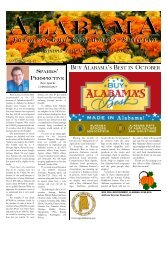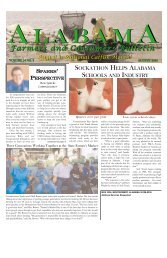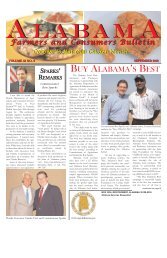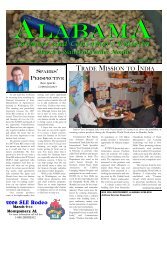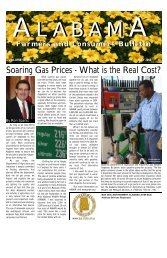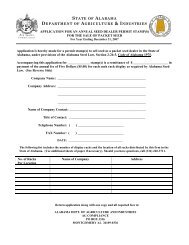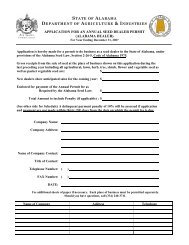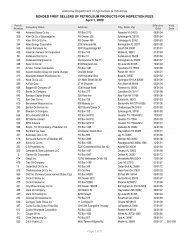Lessons Learned from Rural Schools - Alabama Department of ...
Lessons Learned from Rural Schools - Alabama Department of ...
Lessons Learned from Rural Schools - Alabama Department of ...
Create successful ePaper yourself
Turn your PDF publications into a flip-book with our unique Google optimized e-Paper software.
LLS-0010 <strong>Lessons</strong> <strong>Learned</strong>_Pub.qrk: 4/25/09 3:02 PM Page 17<br />
What Happens When The Bell Rings?<br />
By Owen Sweatt, Ph.D.<br />
Do you remember your first grade classroom?<br />
What color was the floor? What did your desk<br />
look like? How big was the blackboard? What<br />
was your teacher’s name?<br />
My guess is that far more <strong>of</strong> us can remember who<br />
taught us in the first grade than can remember our<br />
physical surroundings. Which is why any serious look at<br />
how a school performs as it does must look carefully at<br />
how teachers work with their students, how administrators<br />
interact with staff and how both students and staff<br />
are motivated.<br />
We studied these schools by using interviews, observations,<br />
and questionnaires to obtain information. Each<br />
school assembled a group <strong>of</strong> parents and a group <strong>of</strong><br />
teachers to be interviewed separately to share information<br />
and perceptions about why they felt their schools were successful.<br />
Each principal was interviewed and completed a<br />
situational questionnaire to determine his or her leadership<br />
style. Patterns were identified <strong>from</strong> the data, categorized<br />
and used to display the results shared in this section.<br />
This section examines the reasons for success as they related<br />
to leadership and motivation <strong>of</strong> the students, teachers<br />
and principal. Since only one <strong>of</strong> the three researchers<br />
has worked in education, this study examined schools with<br />
different perspectives than most “educational research.”<br />
With these thoughts in mind, we share our findings.<br />
Assumptions<br />
1. Focus groups <strong>of</strong> teachers and parents were representative<br />
<strong>of</strong> the general population <strong>of</strong> teachers and parents.<br />
2. Participants were truthful and open regarding their perceptions<br />
and experiences.<br />
3. The assignment <strong>of</strong> motivational and leadership theory<br />
by the author to the behavior described by the participants<br />
is accurate.<br />
Limitations<br />
1. This was not an attempt to measure and assess all<br />
aspects <strong>of</strong> the educational process because <strong>of</strong> the scope,<br />
expertise, and time.<br />
2. Information was gathered <strong>from</strong> limited observation and<br />
question/answer sessions.<br />
3. Only elementary schools (one K-8 school) were<br />
assessed.<br />
<strong>Lessons</strong> <strong>Learned</strong> <strong>from</strong> <strong>Rural</strong> <strong>Schools</strong> – May 2009<br />
What we did not find<br />
• a magic formula for success<br />
• a consensus <strong>of</strong> leadership styles <strong>of</strong> principals<br />
• a consensus <strong>of</strong> what motivates principals or how they use<br />
motivation<br />
• a consistent community pr<strong>of</strong>ile<br />
• a consistent uniform policy (4 out <strong>of</strong> 10 have uniforms)<br />
• similar school construction and size<br />
• consistent level <strong>of</strong> parental involvement<br />
What we did find<br />
• A lot <strong>of</strong> qualified and dedicated school personnel<br />
• “Family” and “Team” used to describe faculty relationships<br />
at school<br />
• High expectations for success, both spoken and written<br />
• State and Federal policies give structure and accountability<br />
standards that have produced positive results. However,<br />
these policies and procedures also limit some teacher’s involvement<br />
in child development and can impede some <strong>of</strong><br />
the progress <strong>of</strong> high performing schools.<br />
• Discipline in schools was, as one person noted, “an issue,<br />
but not a problem.”<br />
• Not all children were motivated by the same things, but<br />
most children can be motivated to accomplish individual<br />
and school goals.<br />
• All faculty were not motivated by the same things, however,<br />
all staff and faculty that were interviewed expressed a<br />
love for teaching and for the children entrusted in their<br />
care.<br />
• Bigger is not always bigger--the size <strong>of</strong> the schools (seven<br />
<strong>of</strong> the ten schools have fewer than 400 students) seemed to<br />
facilitate building relationships. Other benefits <strong>from</strong> the<br />
small schools and rural areas included high salary in their<br />
communities (to attract and keep teachers), status, and affiliation.<br />
• <strong>Schools</strong> used multiple avenues <strong>of</strong> communication with<br />
parents and the community.<br />
• <strong>Schools</strong> were the hub <strong>of</strong> their communities and were a<br />
safe, secure environment for students.<br />
• The cultures among the schools were quite different, but<br />
reflected values <strong>of</strong> their respective communities. The really<br />
strong cultures in some schools were influencing the<br />
values in their communities.<br />
• The perceptions <strong>of</strong> why the schools were successful were<br />
not always the same between the faculty and administration.<br />
17



